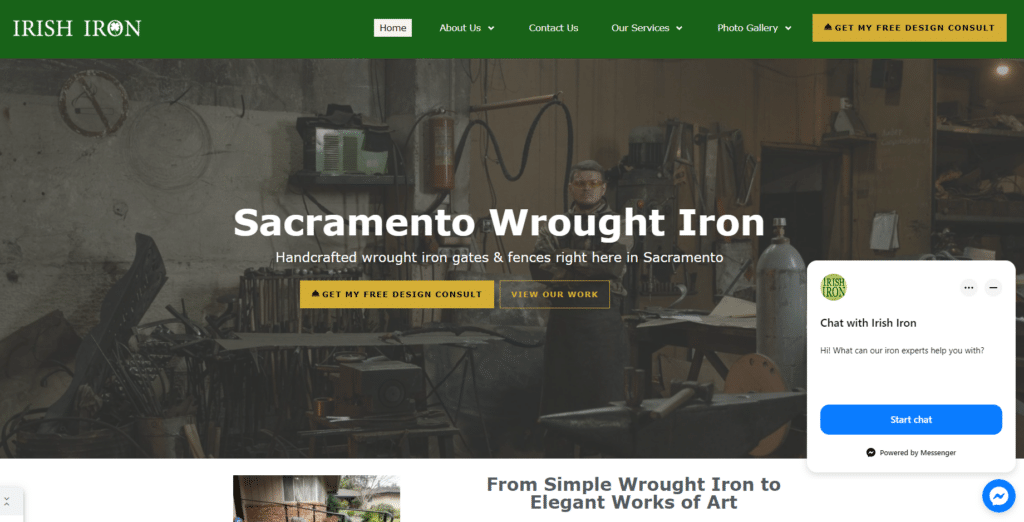Introduction
In the ever-evolving digital landscape, businesses are constantly seeking ways to optimize their online presence, improve user experience, and gain a competitive edge. One such method gaining traction is server-side tagging. But what is it, and why should businesses like Irish Iron consider making the switch?
Server-Side vs. Browser-Side Tagging: A Quick Comparison
- Browser-Side (Client-Side) Tagging:
- Executes on the user’s browser.
- Can slow down website performance due to multiple tags firing.
- More vulnerable to data privacy issues.
- Server-Side Tagging:
- Executes on the server, away from the user’s browser.
- Offers faster website performance and improved user experience.
- Enhanced data security and accuracy.
Switching to server-side tagging can significantly enhance website performance, improve data accuracy, and ensure better compliance with data privacy regulations.
Irish Iron: A Digital Evolution Case Study
For nearly a decade, Irish Iron‘s digital presence was akin to a static business card. Their website, while functional, lacked the dynamism and interactivity that today’s digital consumers crave. Rooted in a mindset of complacency, they believed that if it wasn’t broken, why fix it? However, this approach, while cost-effective in the short term, risked obsolescence as competitors began leveraging advanced digital tools.

But as the digital world evolved, so did Irish Iron’s realization of its potential. The mere existence of a website was no longer a badge of digital accomplishment. The focus shifted to the quality of online presence, user engagement, and conversion capabilities.
In 2016, Irish Iron took their first significant step towards digital modernization. They overhauled their website, prioritizing user experience, intuitive navigation, and interactive features. This transformation wasn’t just about aesthetics; it was about functionality, engagement, and staying relevant in a digital-first world. By 2021, they were ready for another leap, integrating AI-driven chatbots, video testimonials, and a virtual showroom.

Beyond the website, their digital strategy expanded to include a state-of-the-art CRM system, personalized email campaigns, and a robust brand awareness strategy leveraging social media and influencer collaborations. They recognized that the digital audience was distinct, requiring a unique approach to messaging. Hence, they adopted a storytelling strategy, emphasizing their craftsmanship, tradition, and innovation.
However, by 2021, with a revamped digital strategy in place, Irish Iron sought further optimization opportunities. Server-side tagging emerged as a promising avenue, promising improved digital ad performance, faster website load times, and enhanced SEO capabilities.
In the subsequent sections, we’ll delve deeper into server-side tagging, its benefits, and how it can be a game-changer for businesses like Irish Iron, aiming to stay ahead in the digital curve.
What is Server-Side Tagging?
To truly grasp the concept of server-side tagging and its distinction from client-side tagging, let’s use a metaphor: imagine a bustling city post office (your website). Every day, countless letters (data) are sent and received. Now, there are two ways to handle these letters.
Client-Side Tagging: The Busy Street Vendor
Imagine a street vendor set up right outside the post office. Every time someone wants to send or receive a letter, they have to go through this vendor. The vendor handles each letter individually, stamping them, sorting them, and then passing them on to the post office or the recipient. While this method works, it’s not the most efficient. The vendor can get overwhelmed during peak times, causing delays. Plus, since everything happens out in the open, there’s a risk of letters getting lost, mishandled, or even read by prying eyes.
Server-Side Tagging: The Efficient Post Office Clerk
Now, imagine an efficient clerk inside the post office. Instead of handling letters out on the street, they manage everything within the confines of the post office. They have access to all the tools and resources they need, and they can process multiple letters simultaneously. This method is faster, more secure, and ensures that each letter is handled accurately and promptly.
Diving Deeper: The Technicalities
Client-Side Tagging: This is the traditional method where tags (small pieces of code) are executed directly in the user’s browser when they visit a website. These tags collect data and send it to various third-party platforms like analytics tools, advertising networks, and more. However, because everything happens on the user’s device, it can slow down website performance, especially if there are many tags to process. Additionally, with increasing data privacy regulations, client-side tagging can pose challenges in ensuring compliance.
Server-Side Tagging: In this method, the tags are executed on a server, away from the user’s browser. When a user visits a website, instead of processing all the tags on their device, a single request is sent to the server. The server then handles all the tags, processes the data, and sends it to the necessary third-party platforms. This offloads the heavy lifting from the user’s device, leading to faster website load times. Moreover, since the data processing happens on the server, it offers enhanced data security and accuracy.
Why Migrate to Server-Side Tagging?
In the age of digital transformation, businesses are not just looking to establish an online presence; they’re aiming to optimize every facet of their digital strategy. Server-side tagging emerges as a pivotal component in this optimization journey. But why should businesses, especially those like Irish Iron, who have already undergone significant digital transformations, consider this migration? Below are just a few examples of how value can be generated by the switch to server-side.
Improved Website Performance: The SEO Advantage
Website performance is not just about speed; it’s about delivering content efficiently to users and search engines alike. Slow-loading websites can deter users, leading to higher bounce rates. Search engines, especially Google, consider website speed as a ranking factor. A faster website can lead to:
- Higher Search Engine Rankings: Faster load times can improve a website’s position on search engine results pages (SERPs). For instance, Google’s Core Web Vitals, introduced in 2020, emphasizes the importance of website performance, including loading speed.
- Increased Organic Traffic: With better rankings come more visibility and, consequently, more organic traffic. For businesses like Irish Iron, this could mean attracting more potential customers searching for ornamental iron products.
Enhanced User Experience: Boosting Conversion Rates
A seamless user experience is paramount in today’s digital landscape. Users have little patience for slow-loading pages or glitchy interfaces. By migrating to server-side tagging and improving site speed:
- Higher Engagement: Faster websites keep users engaged, reducing the chances of them leaving out of frustration.
- Increased Conversion Rates: A study by Google found that as page load time goes from 1s to 3s, the probability of bounce increases by 32%. By ensuring quick load times, businesses can retain more visitors on their landing pages, leading to higher chances of conversions, be it form submissions, product purchases, or newsletter sign-ups.
Enhanced Data Accuracy: Optimizing Paid Ad Performance
In the world of digital advertising, data is king. The accuracy of this data determines the effectiveness of ad campaigns. With server-side tagging:
- Reduced Data Loss: Client-side tagging can sometimes be blocked by browser settings or extensions, leading to data loss. Server-side tagging minimizes this risk.
- Improved Ad Targeting: Accurate data ensures that ads are displayed to the most relevant audience, optimizing ad spend.
- Higher ROI on Ad Campaigns: With better targeting and reduced data loss, businesses can achieve a higher return on investment for their advertising campaigns. For instance, if Irish Iron were to run a targeted ad campaign for a new product line, accurate data would ensure that their ads reach potential customers genuinely interested in ornamental iron products, leading to higher conversion rates.
Data Privacy and Compliance: Staying Ahead of Regulations
With increasing concerns about data privacy, regulations like the General Data Protection Regulation (GDPR) and the California Consumer Privacy Act (CCPA) have come into play. Server-side tagging offers:
- Enhanced Data Security: By processing data on the server, there’s less risk of data breaches or unauthorized access.
- Easier Compliance: Server-side tagging can be configured to ensure that data collection and processing align with various data protection regulations, reducing the risk of potential legal repercussions.
For businesses like Irish Iron, which have already recognized the power of digital transformation, migrating to server-side tagging is the next logical step. It’s not just about keeping up with technological advancements; it’s about harnessing these advancements to drive growth, improve efficiency, and offer unparalleled value to customers. In the ever-competitive digital realm, staying ahead of the curve is not just an advantage; it’s a necessity.
The Costs
When Irish Iron decided to migrate to server-side tagging, it was crucial to weigh the costs against the potential benefits. Here’s a detailed breakdown of their investment and the recurring expenses they encountered.
Fixed Costs
- Training: To ensure their team was well-versed with the new system, Irish Iron invested in training sessions. This amounted to a one-time cost of $500.
- Implementation: While the bulk of the migration was handled in-house, which cost them around $1,000, they also sought external expertise to ensure a seamless transition. This led to an additional consulting fee.
Recurring Costs
- Server Maintenance with Google Cloud Platform: As per Google’s recommendation, Irish Iron set up at least three instances of App Engine on the Google Cloud Platform. Each of these instances costs approximately $40 per month. This translates to a minimum annual cost of $1,440. However, the actual cost can vary based on:
- Network Egress: The cost associated with all outgoing HTTP traffic from the server endpoint.
- Logging: Expenses related to recording and storing logs for data analysis.
- Server Instances: Websites with high traffic might need more than three server instances, which would increase the overall cost.
- Renting Server Space from Third Parties: For many businesses, using a cloud solution provider for hosting the server is more viable due to the requirements of security, uptime, and scalability. The costs here are influenced by:
- Server-based Events: The more traffic a website receives, the higher the cost due to increased server-based event tracking.
- Originating Data Sources: Extracting data from more sources can increase costs.
- Destination Data Sources (API Integrations): Sending data to more sources can also raise the expenses.
- Cloud Servers Rented: Each additional server rented typically costs around $40 per month.
- Additional Services: Services like tag error monitoring, conversion monitoring, and real-time reporting can add to the monthly expenses.
For a website like Irish Iron, with moderate traffic and multiple data sources, the server rental costs might look like:
Minimum/fixed monthly cost: $120 (for 3 servers)
Additional costs for higher traffic and tags: $120-$180 (3-6 servers)
Logs: Approximately $100 for 500,000 requests
This means that the total annual cost for server-side tagging for Irish Iron ranges from $3,000 to $3,500, and a one-time cost of $3,000 to setup.
The Return
In the realm of digital transformation, investments are not just about the immediate costs but the long-term value they bring. For Irish Iron, the migration to server-side tagging was a strategic move, and the benefits reaped were both tangible and intangible. Let’s delve into the return on investment they experienced:
Website Performance
Improved Load Times: One of the most immediate and noticeable benefits was the enhancement in website speed. The page load time saw a significant reduction, increasing by 3 seconds on average. This not only improved the user experience but also had SEO implications, potentially boosting the site’s ranking on search engine results pages.
Increased Conversion Rate: A faster website often translates to higher user engagement and reduced bounce rates. For Irish Iron, this meant their conversion rate improved, going from 4.3% to a commendable 5.6% on average. This uptick can be attributed to users spending more time on the site, exploring products, and eventually making a purchase or inquiry.
Data Insights
Accurate Data Collection: With server-side tagging, Irish Iron experienced enhanced accuracy in data collection. This meant that their marketing decisions were based on reliable data, leading to more effective campaigns and strategies.
Boost in Attributed Conversions: The accuracy in data collection had a direct impact on their paid channels. They saw an 18% increase in attributed conversions, indicating that their ads were reaching the right audience and resonating with them.
Customer Trust
Enhanced Data Security: In an age where data breaches are all too common, ensuring data security is paramount. Server-side tagging offers a more secure way of collecting and processing data, which not only complies with data protection regulations but also instills trust in customers. Knowing that their data is being handled securely can enhance the overall customer experience and loyalty.
Operational Efficiency
Streamlined Data Collection: With server-side tagging, Irish Iron could streamline their data collection processes. This meant reduced reliance on third-party cookies, which are not only becoming obsolete but also pose data security risks.
Reduced CPA on Paid Channels: Operational efficiency also translated to financial efficiency. Irish Iron experienced a 22% reduction in the Cost Per Acquisition (CPA) on their paid channels. This means they were getting more value for every dollar spent, optimizing their ad spend and maximizing their ROI.
Direct Value from the Changes
Since implementing the change, Irish Iron saw 2326 site visitors. With the conversion rate jumping from 4.3% to 5.6%, they secured 30 more leads than they would have with the previous rate. Given that each conversion is worth $600, this translates to an additional value of $18,000 in lead generation in just the first three months. And this is just the beginning. As paid channels benefit from improved tracking and as Google recognizes the speed improvements, the results are expected to magnify, further amplifying the ROI.
Challenges Faced and Overcome
Every transformative journey comes with its set of challenges, and Irish Iron’s migration to server-side tagging was no exception. However, with resilience and a proactive approach, they managed to navigate these challenges effectively. Here’s a look at some of the hurdles they faced and how they overcame them:
Potential Hiccups in the Migration Process
Challenge: Like any major digital overhaul, the migration process had its moments of uncertainty. There were concerns about potential data loss, misconfigurations, and disruptions to ongoing marketing campaigns.
Solution: Irish Iron employed a phased migration approach. They started with non-critical sections of their website, allowing them to test and refine the process before fully transitioning. Regular backups and close collaboration with their IT team ensured a smooth migration.
Training Staff to Understand and Utilize the New System
Challenge: With the new system in place, there was a need to ensure that the staff was well-versed with its functionalities to leverage its full potential.
Solution: Irish Iron invested in comprehensive training sessions, both in-house and through external experts.
Ensuring Compliance with Data Privacy Regulations
Challenge: With the shift to server-side tagging, there was a heightened focus on data privacy. Ensuring compliance with evolving data protection regulations became paramount.
Solution: Irish Iron collaborated with legal experts specializing in digital data compliance. Regular audits, coupled with training on data privacy best practices, ensured that they remained compliant while safeguarding user data.
Takeaways for Other Businesses
Irish Iron’s journey offers valuable insights for other businesses contemplating a similar digital transformation. Here are some key takeaways:
Evaluate Current Tagging Systems:
Before diving into a migration, it’s crucial to evaluate the current tagging system’s performance. Understand its limitations and the potential benefits of migrating to server-side tagging. This will provide a clear roadmap and justification for the transition.
Balance Initial Costs with Long-Term Benefits:
While the initial investment in server-side tagging might seem substantial, it’s essential to view it in the context of long-term benefits. Improved website performance, accurate data insights, and enhanced user trust can lead to significant ROI in the long run.
Stay Updated with Digital Trends:
The digital landscape is ever-evolving. To remain competitive, businesses must stay updated with the latest trends and technologies. Regularly review and refine digital strategies to ensure they align with current best practices and industry standards.
Conclusion
In the ever-evolving digital landscape, Irish Iron’s transformative journey stands as a testament to the power of embracing change. From their initial digital inertia to their proactive adoption of server-side tagging, their story is a compelling narrative of growth, resilience, and innovation. It underscores the significance of not just having a digital presence but optimizing it to its fullest potential.
The digital realm is not static; it’s dynamic and constantly shifting. Businesses that remain complacent risk being left behind, while those that adapt and evolve can harness the myriad opportunities that the digital world offers. Irish Iron’s success story serves as a beacon for other businesses, illuminating the path to digital excellence.
For businesses reading this, the message is clear: The future belongs to those who innovate. It’s not just about keeping up with the times; it’s about leading the charge, setting industry standards, and crafting unique digital experiences for your audience.
At Cosmoforge, we’re committed to helping businesses navigate the complexities of the digital world. Whether you’re looking to revamp your digital strategy, migrate to server-side tagging, or explore other modern digital tools, our team of experts is here to guide you every step of the way.
Ready to embark on your digital transformation journey? Let’s forge the future together. Get started with Cosmoforge today: Contact Us.




